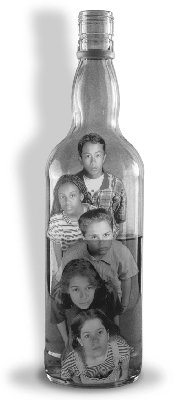|
HOME
DISINFORMATION
PEOPLE
BRONFMAN
Edgar Bronfman Senior Letter 06 16-Jun-2000 Vivendi absorbing Seagram is inconceivable As the broken bodies, disintegrated families, disease and affliction are tallied in America and the world, we have but one question to ask the undertaker: "Have we reached six million yet?" � Blacks and Jews Chairman The Seagram Company, Ltd. 1430 Peel Street Montreal, Quebec H3A 1S9 Edgar M. Bronfman: I am writing to you in connection with the proposed merger of Seagram with French conglomerate, Vivendi SA, at a cost to the latter of some US$30-billion. In connection with this merger, perhaps you will explain to me how the following two obstacles are to be overcome: (1) How will the Seagram-Vivendi ethics gap be bridged? If you examine the Vivendi web site at www.vivendi.com, you will notice that its theme is happy children:
Perhaps Vivendi has a right to identify itself with happy children � its outstanding role has been that of supplier of potable water, and providing safe, drinkable water is perhaps the one measure which has done more than any other to improve public health and increase longevity. If the delivery of potable water were halted, there can be little doubt that epidemics would break out, and that life expectancy would plummet. So, yes Vivendi can indeed take credit for doing good and for producing happy children, most notably in supplying clean water, but perhaps in other of its activities as well. Seagram too has a connection with children, though not quite such a happy one:
You will recollect that the above material prefaced a 02-Aug-1996 open letter to Seagram signed by a long list of notables, among them U.S. Senator Robert C. Byrd, and supported by a long list of organizations, among them the American College of Physicians. That letter urged Seagram to reverse its decision to break a 48-year voluntary ban against hard-liquor advertising on TV. The letter contained the following paragraph:
And so, the contrast couldn't be more striking. Vivendi brings health; Seagram brings sickness. Vivendi brings life; Seagram brings death. Thus, it will not be easy for Vivendi to acquire Seagram without blemishing the Vivendi image. After acquiring Seagram, it would not be quite as appropriate to have all those happy children on the Vivendi web site. After acquiring Seagram, one would wonder what was the use of having Ethical Standards Officer Sylvie d'Arvisenet continuing to sit on the Vivendi Executive Committee. After acquiring Seagram, the very name "Vivendi" created out of a root meaning "life" would begin to seem disingenuous. After acquiring Seagram, Vivendi would no longer be able to claim as it does today that among its highest values are the following:
As Seagram's own overriding value is to make money without regard to the swath of destruction that it leaves behind, it is hard to imagine how Vivendi will be able to swallow Seagram without suffering ethical indigestion afterward. (2) Will Vivendi end up paying for Seagram's crimes? As you are active in the compensate-me-for-past-wrongs movement, you will have noticed that Jews winning compensation from Germany and Switzerland for wrongs suffered during World War II is only a part of a much larger enterprise, and that other examples are ailing women with breast implants suing Dow-Corning, diseased smokers suing tobacco companies, abused boarding-school students suing the Anglican church, and dispossesed North American Indians suing governments for return of ancestral land. In each such case, the total claimed by plaintiffs exceeds, or threatens to exceed, the total assets of the respondents, as for example the total land claimed by all Indians in the Canadian province of British Columbia exceeds the total land area of British Columbia. The compensate-me-for-past-wrongs movement is so popular, however, that it is hard to imagine that the liquor industry will be able to avoid being targeted in its turn. With respect to Seagram, estimating its legal liability must begin with two critical pieces of information: (1) What has been the Years of Potential Life Lost (YPLL) that is attributable to Seagram in various times and places? Although I have not seen such numbers computed, I have argued in my letter to you of 31-Mar-2000 that this YPLL is likely to be so large as to justify use of the expression "Seagram Holocaust." (2) What might future litigation cost Seagram for each YPLL? It is plausible to suppose that even low estimates in the two above categories would indicate that current evaluations of Seagram worth must be reduced substantially in anticipation of costs and losses resulting from future litigation. More important, it is also plausible to suppose that higher estimates of Seagram-Holocaust YPLL and higher projections of litigation costs for each YPLL could lead to an estimated liability that exceeds Seagram worth. In other words, it is conceivable that some time in the not-too-distant future, forfeiture of all Seagram assets would not compensate the damage that Seagram was being held responsible for having inflicted, and Seagram would be driven into bankruptcy. Lawsuits might be particularly effective when mounted by groups such as North American Indians or Blacks who might be able to argue that aggressive and reckless marketing by Seagram not only caused vast individual suffering and death, but played a leading role in the destruction of their societies. Here is a quotation which reflects the thinking of some American Blacks, and which gives the appearance of being one step away from launching a mammoth class-action law suit:
As things stand today, Seagram can be blamed for a Seagram Holocaust, but Vivendi can only be credited with having saved lives; but under the proposed merger, Seagram would vanish, and Vivendi would not only assume responsibility for the Seagram Holocaust, but would take over its implementation under the new name of the Vivendi Holocaust. As things stand today, there exists an Edgar the Terrible of Seagram; but under the proposed merger, Edgar would recede from center stage, and a Jean-Marie Messier the Terrible of Vivendi would step forward to play that same destructive role. Perhaps Vivendi would be able to implement its plan of divesting itself of Seagram liquor holdings (keeping only the Seagram media holdings) so rapidly that no litigation had a chance to break out. However, "rapidly" in this context might mean years, and no more than the first indications of serious litigation � indeed, no more than a broadening discussion of Seagram liability � might trigger investor disenchantment. The Seagram-Vivendi merger at a cost of US$30-billion is inconceivable In short, it seems inconceivable that an entity that has done as much good in the world as Vivendi would merge with an entity that has inflicted as much harm as Seagram, and it seems inconceivable as well that calculation of Seagram worth could omit to subtract the compensation that Seagram might soon be asked to pay for the harm that it has caused. Lubomyr Prytulak cc: Jean-Marie Messier, Chairman and CEO Eric Licoys, Chief operating officer Henri Proglio, Senior executive vice president, Environment Philippe Germond, Senior executive vice president, Communications Jean-François Colin, Executive vice president, Human Resources Guillaume Hannezo, Executive vice president, Finance Jean-François Dubos, Company secretary Christine Delavennat, Corporate Communication Thierry de Beaucé, International Affairs Agnès Audier, Strategy and Business Development Sylvie d'Arvisenet, Ethical standards Vivendi Holding Company 42, avenue de Friedland 75380 Paris France James Harding Kathryn Leger Matthew Fraser National Post 300-1450 Don Mills Road Don Mills, ON M3B 3R5 HOME DISINFORMATION PEOPLE BRONFMAN |

















